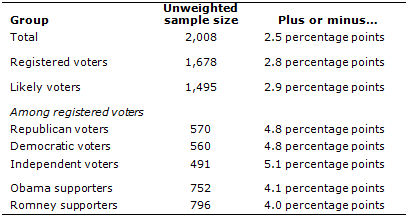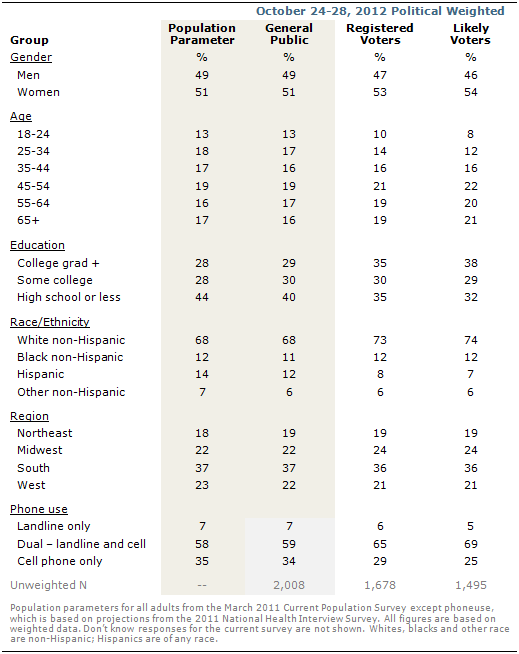Most of the analysis in this report is based on telephone interviews conducted October 24-28, 2012, among a national sample of 2,008 adults, 18 years of age or older, living in all 50 U.S. states and the District of Columbia (1,204 respondents were interviewed on a landline telephone, and 804 were interviewed on a cell phone, including 433 who had no landline telephone). Data collection was managed by Princeton Survey Research Associates International and conducted by interviewers at Princeton Data Source and Abt SRBI. A combination of landline and cell phone random digit dial samples were used; both samples were provided by Survey Sampling International. Interviews were conducted in English and Spanish. Respondents in the landline sample were selected by randomly asking for the youngest adult male or female who is now at home. Interviews in the cell sample were conducted with the person who answered the phone, if that person was an adult 18 years of age or older. For detailed information about our survey methodology, see https://www.pewresearch.org/politics/methodology/
The combined landline and cell phone sample are weighted using an iterative technique that matches gender, age, education, race, Hispanic origin and nativity and region to parameters from the March 2011 Census Bureau’s Current Population Survey and population density to parameters from the 2010 Census. The sample also is weighted to match current patterns of telephone status and relative usage of landline and cell phones (for those with both), based on extrapolations from the 2011 National Health Interview Survey. The weighting procedure also accounts for the fact that respondents with both landline and cell phones have a greater probability of being included in the combined sample and adjusts for household size among respondents with a landline phone. Sampling errors and statistical tests of significance take into account the effect of weighting. The following table shows the unweighted sample sizes and the error attributable to sampling that would be expected at the 95% level of confidence for different groups in the survey:

Some of the analysis in this report is based on telephone interviews conducted October 18-21, 2012, among a national sample of 1,005 adults 18 years of age or older living in the continental United States (601 respondents were interviewed on a landline telephone, and 404 were interviewed on a cell phone, including 224 who had no landline telephone). The survey was conducted by interviewers at Princeton Data Source under the direction of Princeton Survey Research Associates International. A combination of landline and cell phone random digit dial samples were used; both samples were provided by Survey Sampling International. Interviews were conducted in English. Respondents in the landline sample were selected by randomly asking for the youngest adult male or female who is now at home. Interviews in the cell sample were conducted with the person who answered the phone, if that person was an adult 18 years of age or older. For detailed information about our survey methodology, see: https://www.pewresearch.org/politics/methodology/.
The combined landline and cell phone sample are weighted using an iterative technique that matches gender, age, education, race, Hispanic origin and region to parameters from the March 2011 Census Bureau’s Current Population Survey and population density to parameters from the Decennial Census. The sample also is weighted to match current patterns of telephone status, based on extrapolations from the 2011 National Health Interview Survey. The weighting procedure also accounts for the fact that respondents with both landline and cell phones have a greater probability of being included in the combined sample and adjusts for household size among respondents with a landline phone. Sampling errors and statistical tests of significance take into account the effect of weighting. The following table shows the unweighted sample size and the error attributable to sampling that would be expected at the 95% level of confidence for the total sample:

Sample sizes and sampling errors for other subgroups are available upon request.
In addition to sampling error, one should bear in mind that question wording and practical difficulties in conducting surveys can introduce error or bias into the findings of opinion polls.
Likely Voter Scale
Likely voter estimates are based on a 9-item turnout scale that includes the following questions: thought, campnii, precinct, oftvote, where, plan1/plan3, folgov, pvote08a and scale10. The turnout estimate used in identifying likely voters is 59%. More details about the Pew Research Center’s methodology for estimating likelihood to vote are available at https://assets.pewresearch.org/wp-content/uploads/sites/5/2011/01/UnderstandingLikelyVoters.pdf.
Sample Composition
The following table shows the profile of all adults interviewed, compared with population parameters from government surveys, as well as the profile of registered and likely voters interviewed.

© Pew Research Center, 2012